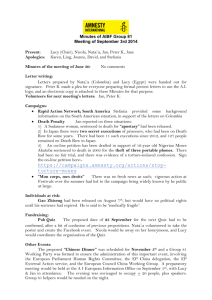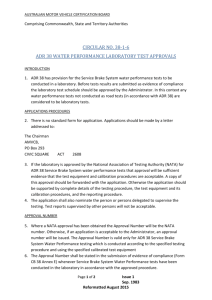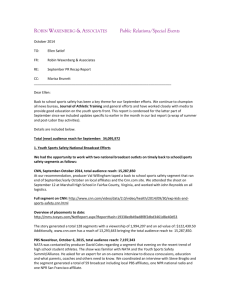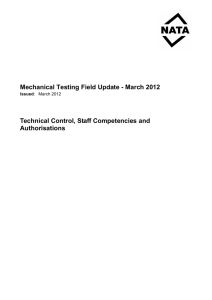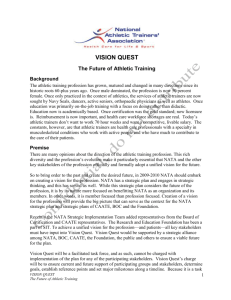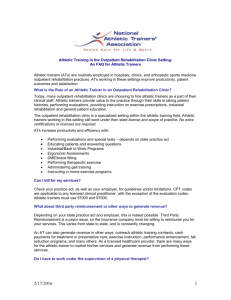SIT Meeting Notes
advertisement
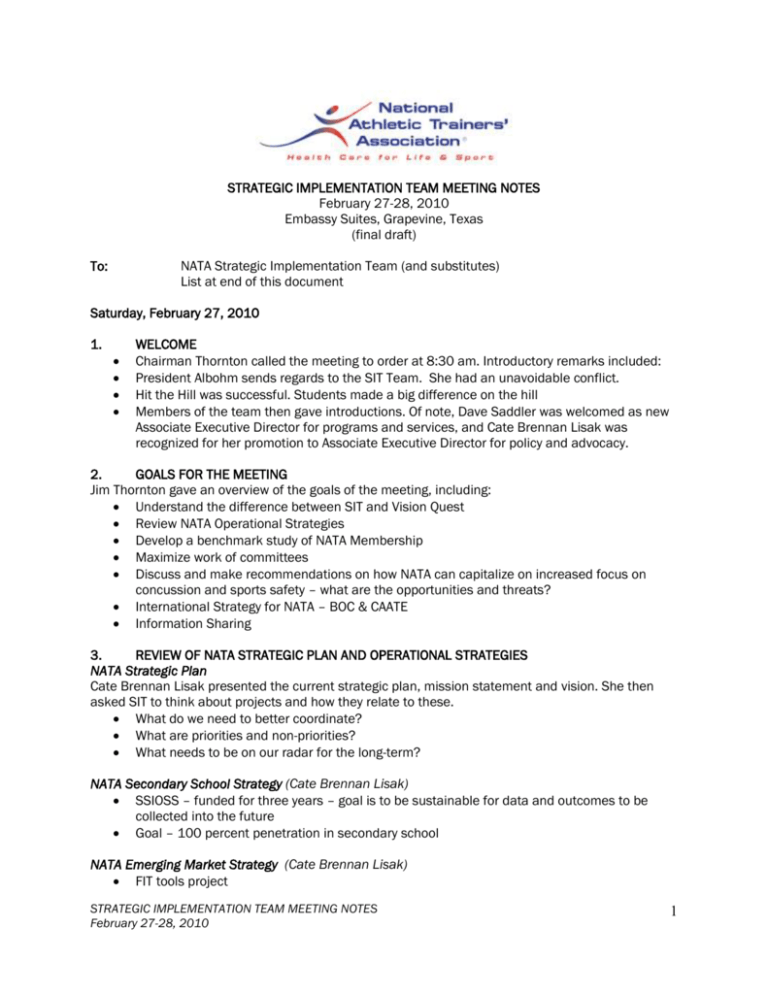
STRATEGIC IMPLEMENTATION TEAM MEETING NOTES February 27-28, 2010 Embassy Suites, Grapevine, Texas (final draft) To: NATA Strategic Implementation Team (and substitutes) List at end of this document Saturday, February 27, 2010 1. WELCOME Chairman Thornton called the meeting to order at 8:30 am. Introductory remarks included: President Albohm sends regards to the SIT Team. She had an unavoidable conflict. Hit the Hill was successful. Students made a big difference on the hill Members of the team then gave introductions. Of note, Dave Saddler was welcomed as new Associate Executive Director for programs and services, and Cate Brennan Lisak was recognized for her promotion to Associate Executive Director for policy and advocacy. 2. GOALS FOR THE MEETING Jim Thornton gave an overview of the goals of the meeting, including: Understand the difference between SIT and Vision Quest Review NATA Operational Strategies Develop a benchmark study of NATA Membership Maximize work of committees Discuss and make recommendations on how NATA can capitalize on increased focus on concussion and sports safety – what are the opportunities and threats? International Strategy for NATA – BOC & CAATE Information Sharing 3. REVIEW OF NATA STRATEGIC PLAN AND OPERATIONAL STRATEGIES NATA Strategic Plan Cate Brennan Lisak presented the current strategic plan, mission statement and vision. She then asked SIT to think about projects and how they relate to these. What do we need to better coordinate? What are priorities and non-priorities? What needs to be on our radar for the long-term? NATA Secondary School Strategy (Cate Brennan Lisak) SSIOSS – funded for three years – goal is to be sustainable for data and outcomes to be collected into the future Goal – 100 percent penetration in secondary school NATA Emerging Market Strategy (Cate Brennan Lisak) FIT tools project STRATEGIC IMPLEMENTATION TEAM MEETING NOTES February 27-28, 2010 1 Educating new employers Mid career experiences – creating career ladders for members who leave collegiate and secondary school settings External advocacy Revenue Legislation NATA Knowledge Initiatives Strategy (Anita James) Focus on education Quality provider of continuing education Add member value Produce additional revenue streams Lindsey is now the liaison to CPC, Anita is liaison to CEC Knowledge Initiatives Duties – Events, E-Learning & Products (ATrack, Exam Study Guide) Expansion of the quiz center – 2 new CEUs per month Should we sell online courses to different groups? Could bundle for sale to educators, coaches, etc. Focus for 2010 Grow e learning offerings Comprehensive metrics system Continue focus on educators and related programs Build necessary infrastructure NATA Membership Services (John Honaman) Higher level of membership currently – lower percentage paid at this point compared to last year 32 percent of members have employers pay their dues Dues in Installments - Extending installments this year – but members are counted as unpaid until membership is fully paid Percentage of total certified members has decreased over time though we have the current largest number of certified members overall Member value provided by membership ½ million in value in 2009 Integrate marketing and messaging Advertising on website Range of Motion, Facebook, Twitter, Photo Zone Student Initiatives – ATRAck, Honor society have lead to an increase in student members from last year Patient Care Information to Members. Looking into CATmaker, which allows you to post peer reviewed research with the ability to comment Cross functional taskforce to look into certifieds who are not members of NATA Looking to create more marketing opportunities for sponsors, build more affinity programs. Employers are more likely to pay continuing education than dues. NATA has new invoicing that focuses on CEU fees that equal up to the dues amount. ACSM has done something similar and it has been effective. STRATEGIC IMPLEMENTATION TEAM MEETING NOTES February 27-28, 2010 2 4.1. SIT ENVIRONMENTAL SCAN Jim Thornton reviewed the environmental scan for the group. The three most important issues based on SIT responses were: Increase domestic membership Diversity of revenue sources More value for dues Highest priority in education Determine if education is meeting employer needs Highest priorities in legislation Passage of HR 1137 Licensure in all states Highest priorities in core activities Increase the number of athletic trainers in secondary schools Protect secondary school, collegiate and pro sports positions Reimbursement Highest priorities in external issues Increase awareness to consumers Improve credibility with physicians Position athletic trainers as professionals in rehabilitation Greatest Issues facing the profession over the next year Member apathy Note: Rachael Oats reviewed NATA’s annual Volunteer Call for involvement. The call goes out every September. 3,400 members answered last yea; only 350 official positions are available. NATA seeks to find new ways to involve members. Members have been utilized to test the AMCIA, test the annual meeting registration site, narrow down proposals for the annual meeting, etc. Action Note: As committee/council chairs, members of SIT are tasked with finding ways to involve more members in volunteer work. Members in the Volunteer Pool can serve on work groups, survey groups, researchers, advocacy letter writers, proposal reviewers, etc. 4.2. DIFFERENCE BETWEEN SIT AND VISION QUEST Jim Thornton explained the differences between the two groups to help eliminate confusion. The Strategic Implementation Team’s role is to monitor the environment related to the NATA Strategic Plan, and review, revise and recommend changes in the plan to the Board of Directors. Additionally, SIT generally does not create its own projects nor assign tasks to the committees. It does not supervise committees or chairs. Instead, its primary mission is to ensure that the major committees are not duplicating work and are actively working to coordinate and cooperate on programs. Vision Quest is an ad hoc group that is focused on the athletic training profession, and creating an aligned vision for NATA, CAATE, BOC and the Foundation. Then the four stakeholder groups will ensure that their individual strategic plans are aligned and do not have competing goals. The SIT team broke into two separate groups for discussion. Workgroup #1: NATA’s current Strategic Plan and proposed baseline/benchmark survey The workgroup presented their plan for a baseline (instead of benchmark) member survey to the rest of the group SIT will make recommendations to the Board of Directors based on the results of the member survey STRATEGIC IMPLEMENTATION TEAM MEETING NOTES February 27-28, 2010 3 Workgroup #2: Connecting the dots between C/U and SS Model Practices, COR Revenue Models, Financial Impact Tools, Secondary School Injury Surveillance and Outcomes System SSISOS update The timeline for SSISOS has been set for January 2011 implementation. NATA has received six letters of intent. One of the biggest challenges is educating the NATA members on why this data is so valuable and important. Among other things, the SSISOS will provide data that will allow people to demonstrate their value to their employers with treatment and outcomes data. Equally important, outcomes data is essential to reimbursement goals and profession’s place within the medical model. Model practices products for C/U and SS Facilities: is there any regulation or accreditation? Does it meet the certain standards? Can the BOC help us out? Documentation: more than ‘soap notes’ outcomes. Hiring conflict of interest: is AD also the head football coach? Is the hiring boss the AD or the principal? What about taking the control from the AD and to the principal? Best practices/model practices are directly linked to patient outcomes. Value Models Secondary school has one College/university: in the pipeline Need to show why to Increase salaries and staff Decrease hours worked; ATs need to improve quality of life 7. WHAT’S THE STRATEGY? ATs IN THE SPOTLIGHT Tremendous media coverage in the past five years on concussion and other athletic injuries. Now coming to the forefront o NATA publishes a concussion statement in 2004; NATA receives extensive news coverage on its concussion practices in USA Today, Baltimore Sun, AP, CNN, UPI, Newsweek, Dallas Morning News, Charlotte Observer, NYT (Jane Brody); NATA releases concussion DVD (2009); Time Magazine, GMA/ESPN, NYT Congressional hearings in 2005 , Steroids (MLB); Novinski’s Head Games (2006) Concussion Congressional hearings (2009-10): High School Athletes- Houston, TX; GAO interviewing and upcoming spring report (2010) Governmental Affairs Council (2007) o Promote Athlete Safety as a legislative strategy o ATs in High Schools o Require AED’s in high Schools (PHW) o Texas Comprehensive Legislation Youth Sports Safety Alliance and Summit (2010) o 120-15- kids died 1/08-12/09 o 30 plus organizations o Website www.youthsportssafetyalliance.org ; Proceedings book o Parent activism on the rise o National Cheerleading Safety Foundation, SafeKids USA, Parent Heart Watch, Brain Injury Association, Sarah Jane Foundation (APBI) STRATEGIC IMPLEMENTATION TEAM MEETING NOTES February 27-28, 2010 4 New External Messages o ATs are experts: ATs save lives! o The AT IS the health care system for some student athletes o ATs take responsibility and lower risk/risk management Legal Issues o Office of the Inspector General o Stark/Anti-kickback laws Future o Keeping ATs in the forefront o Position ATs as integral to safety o The gold standard is the full-time AT 8. DISCUSSION ON NEW ISSUES FROM THE PREVIOUS DAY SIT Team members discussed updating and improving the Web site. 9. DEVELOP AN NATA INTERNATIONAL STRATEGY Judy Pulice presented the need for NATA and its strategic partners, BOC, CAATE and Foundation, to develop an international strategy. She reviewed the following background material: What is role for NATA internationally? The need for an international strategy applies to two categories of the Strategic Plan – Membership & professionalization International Council – focuses on NATA membership World Federation (WFATT) – focuses on institutional members and professionalization Factors – o Free movement of people & services in Western Europe/EU=Bologna Accord – standardization of academic requirements o Entrepreneurial Opportunities: China – huge numbers of teams, people participating in sport WFATT – goal is to create an international certification program & accredit education programs Be the BOC and CAATE but internationally? Is this a threat or opportunity? o International accreditation doesn’t make sense for multiple groups. Needs to be one body – CHEA (Council for Higher Education Accreditation) NATA benefits to international members: Education opportunities, access to peer-reviewed journals, cache of having an American certification, translation of materials (webinars, etc.) WFATT – structured as an association for organizations, not individual members BOC – receives many requests from countries for Mutual Recognition Agreements (MRAs) o Can’t have MRAs with multiple countries o Isn’t a need for a global credential because core skills/knowledge has not been established. Core competencies vary by country and culture. The an global certification tool would need to be validated. WFATT still working to complete the global practice analysis, which began in 2005 Four potential areas for global standardization o Prevention o Assessment o Intervention o Education Terminology issue exist in different countries Nursing and Medicine have good international models STRATEGIC IMPLEMENTATION TEAM MEETING NOTES February 27-28, 2010 5 The challenge will be how to create ways of credentialing international ATS without creating an internship loophole for domestic members Action: SIT needs to start thinking about international issues. This issue will be revisited in the future. 10. COMMITTEE CHAIR UPDATES Young Professionals Council Currently focused on the annual meeting, this will be the first time awarding a national distinction award – 13 nominees. At the annual meeting we will have a social networking event in the young professionals’ lounge. We are publicizing the event to all YPs and inviting BOD members, HOF members and other experienced ATs. The YPC/CUATC survey will be used as a teaser article in the March NATA news. The survey will analyze salary, hours worked, other issues related to college setting. This survey has potential to be a useful tool to see where they are in relation to other ATs. YPC also has a community service event at the annual meeting where 100 kids from the Police Athletic League will come learn about sports medicine and athletic training. Public Relations Council Recently, the council had its first conference call to discuss National Athletic Trainers’ Month. It has been working on the AAOS PSA campaign on back pain. There will be posters at the annual meeting at the PR booth. It emphasized that the think tank has been very active Council on Revenue Council It has two workgroups. One work group on reimbursement terminology and the other work group on analyzing and promoting successful reimbursement models. Ellis said COR has website resources and that ATs should be the content experts on the language for reimbursement, etc. Clinical and Emerging Practices Athletic Trainers’ Committee CEPAT is focusing on the annual meeting – Health Care Management Tracks (HCMT) and workshops. HCMT focuses on healthcare administration, business development and how to set up a business; the three one-hour sessions build on each other. There will be five pre-conference workshops during committee day: beginner and advanced physician extender workshop: beginners and advanced performing arts; and public safety. CDEs (Career Development Experiences) are mid-career setting changes where ATs can spend time with people in that setting (a type of OJT). CEPAT envisions CDEs to be paid positions, primarily. Eventually, the CDEs could develop into clinical sites, which would be helpful since most will be in emerging markets. The primary settings for the CDEs include physician extender, industrial, MLB and performing arts. CDE criteria for being listed on NATA site and evaluation have been developed. There will be a CDE Networking at annual meeting for interested CDE sites and participants. Secondary School Athletic Trainers’ Committee SSATC has had many conference calls, discussions of the Gatorade award and matching career grants. There have not been many grant requests lately. State grants to publicize to enhance secondary school athletic training experience. We have put the high school curriculum project on hold temporarily—other priorities. We have been working on the official statement of proper usage of student high school students. Governmental Affairs Council GAC are concerned that a lot of people are working without an emergency action plan. There are some reimbursement bills. Lobbyist fees are increasing; people recognize who ATs are now. Judy reminded the group that there is a state leadership forum June 24th. STRATEGIC IMPLEMENTATION TEAM MEETING NOTES February 27-28, 2010 6 Professional Education Council The clinical instructor workshop has had some changes. Major project is developing 5th edition of the competencies, we hope to have everything on the website by mid-March and the final draft submitted to board by June. So far we have had good response from SMEAD requests. Executive Committee for Education Sara Brown expects competencies to look different; instead of clinical competencies they will be in aggregate of all the domains. There will be an improvement with patient outcomes. ECE is encouraging people to submit articles to Journal of Athletic Training define framework where education should occur, get embedded and be required into the standards and educate the educator. There are currently 360 AT programs in the U.S. Board of Certification Denise has an action item to understand the role delineation. The full document will be a free pdf download for everyone, creating different formats. District Secretaries/Treasurers’ Committee District secretaries and treasurers a set of standard reports. There was a meeting in the last week of January full of good synergy. Foundation Scholarship and grants program at the annual conference. Many exciting events at the AM, including fun run, foundation night. College University Athletic Trainers’ Committee Awards are open for nominations until March 15th. The committee’s biggest project is the AMCIA online resource that should be ready for rollout in April. This project will be in the NATA News, on the think tanks, Range of Motion and website. Thompson wrote an article for the Council on Higher Education that discusses the different health professional in the C/U setting. 11. HOW’S IT WORKING? ORGANIZATIONAL MANAGEMENT How can we better communicate? Webinars? Elimination of mid-winter meeting is a challenge for committees o Has increased chair workload o Richness of discussion over the phone not as good as in person. Ideas for addressing the issue included meeting in smaller groups and training committee chairs for facilitation Abstract Manager – used for scholarship, convention committee for document sharing – portal to submit and review materials – scholarship and free-com committee Google Docs was also mentioned by the committee Rachael Oats discussed the Volunteer Resource Center, which houses all forms for committee and board members, info on think tanks, etc. The resource center will also proved training for chairs in facilitation and use of software. An online tutorial for chairs and committee members coming in the future Discussion then focused on the strategic plan and how SIT communicates with the Board SIT is comprised on committee chairs, who have a pulse on their setting, and best strategic thinkers in the profession. This is the most qualified group to monitor, analyze and recommend changes to the Board. Chairman Thornton proposed that there may be a need STRATEGIC IMPLEMENTATION TEAM MEETING NOTES February 27-28, 2010 7 for a name change because the SIT Team does not implement anything related to the strategic plan; it monitors, reviews and recommends. The group questioned whether additional Board participation would be helpful. There was concern that the Board was missing some important dialogue SIT decided that it will wait for Vision Quest report before making new recommendations to the Board. SIT’s continued role and name would be revisited then. Other suggestions included making the SIT agenda driven by 1) the Board and/or 2) SITE members Chairman Thornton thanked the chairs for their work with their committees and the SIT Team then called the meeting to close. Respectfully submitted, Cate Brennan Lisak, Associate Executive Director, Policy & Advocacy To: Jim Thornton, MA, ATC, PES, SIT Chair and Board of Directors Marje Albohm, MS, ATC, NATA President John Hauth, EdD, ATC, Continuing Education Council Sara Brown MS, ATC, Executive Committee for Education Kathy Dieringer, EdD, ATC, LAT, Clinical and Emerging Practices AT Committee Lou Fincher, EdD, ATC, LAT, Professional Education Council Marisa Brunett, MS, ATC, LAT, Public Relations Council Linda Mazzoli MS, ATC, PTA, Council on Reimbursement Dwight Eric McDonnell Med, ATC, LAT, Government Affairs Council Charlie Thompson, MS, ATC, College University AT Committee Brian Robinson, MS, ATC, LAT , Secondary School AT Committee Mark Hoffman, PhD, ATC, NATA Research and Education Foundation Kim Detwiler, MS, ATC, CSCS, Young Professionals Council Eric Sauers, PhD, ATC, Post-professional Education Council Denise Fandel, BOC Patsy House, CAATE . And, Brian Conway, ATC, Board of Directors Eve Becker-Doyle, CAE, NATA Executive Director Teresa Foster Welch, Foundation Executive Director Cate Brennan Lisak, CAE, NATA Director of External Affairs John Honaman, Director of Member Services and Business Development Anita James, NATA Meetings Manager Judy Pulice, CAE, NATA National Manager, State Legislative & Regulatory Affairs Ellen Satlof, NATA Public Relations Manager Patty Ellis, NATA National Manager of Markets & Revenue Rachael Oats, CAE, NATA Special Projects Manager Amy Callender, NATA Federal Legislative Manager & NATAPAC Treasurer Russell Lowe, NATA Marketing Research Analyst Kathryn Ayres, NATA External Affairs Coordinator SIT2010/SIT_Meeting_Notes_Feb 2010_FINAL_033010 Rev. YP 040510 – final draft STRATEGIC IMPLEMENTATION TEAM MEETING NOTES February 27-28, 2010 8
